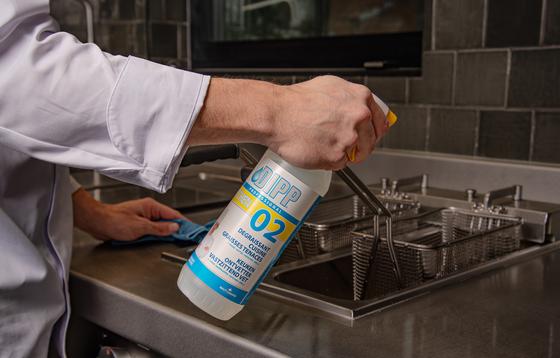
Cleaning According to HACCP
Cleaning According to HACCP
Cleaning is more than just making things look tidy – it is a fundamental step in every food safety plan. While degreasing dissolves dirt, cleaning removes both visible and invisible contamination from surfaces and equipment. Only thorough cleaning provides the right foundation for safe and effective disinfection.
Without proper cleaning? Disinfectants become less effective, bacteria can hide within organic matter, and the risk of contamination increases.
In short: cleaning is essential within HACCP.
Cleaning as a Critical Step in the Hygiene Policy
In a professional kitchen, contamination is everywhere: food residues and microorganisms adhere to work surfaces, equipment, and floors. If not properly removed, this can lead to:
• incomplete disinfection
• reduced food safety
• material damage
• negative audit results
A systematic and thorough cleaning ensures that all surfaces are truly clean – both visually and microbiologically.
The Importance of the Right Cleaning Product
For effective cleaning, choose a product that:
• efficiently removes dirt
• is food-safe and compliant with HACCP guidelines
• rinses quickly and residue-free
DIPP N°24 Kitchen Cleaner Multi Pro is ideal for this purpose. This universal cleaner was specially developed for daily cleaning of kitchens and food processing areas. It removes dirt quickly and safely, leaving no harmful residues after rinsing. Prefer a ready-to-use formula? Choose DIPP N°31 Kitchen Cleaner – an efficient and powerful cleaner that removes grease, food residues, and stubborn dirt. Together, both products ensure a clean, safe, and effective kitchen environment.
How to Clean Properly: Step by Step
Effective cleaning follows a logical, result-driven structure. Follow these 5 steps:
-
Preparation
Remove food residues and grease layers (after degreasing) from the surface. -
Apply Cleaner
Apply the cleaner and allow it to work for a short time. -
Mechanical Cleaning
Use a sponge, brush, or microfiber cloth. Apply color coding to avoid cross-contamination. -
Rinse
Rinse thoroughly with clean water to remove residues and loosened dirt. -
Dry and Inspect
Allow to air dry or wipe with a clean cloth. Visually check if the surface is clean and repeat if necessary.
Cleaning Frequency
Like degreasing, cleaning is not a one-time task but a fixed part of your hygiene policy.
• Daily: worktops, utensils, equipment, oven interiors, floors
• Weekly: refrigerators, storage areas, walls, cutlery trays
• Periodically: behind and under equipment, hard-to-reach areas, sinks
Link cleaning to clear schedules (who, what, when). Use DIPP Professional hygiene planners for structure and follow-up.
Conclusion
Cleaning is an essential step in every HACCP plan. Without proper cleaning, disinfection is less effective, and preventable risks arise. By using effective products such as DIPP N°24 Kitchen Cleaner Multi Pro or DIPP N°31 Kitchen Cleaner, and following a consistent cleaning routine, you ensure a hygienic and food-safe result.


